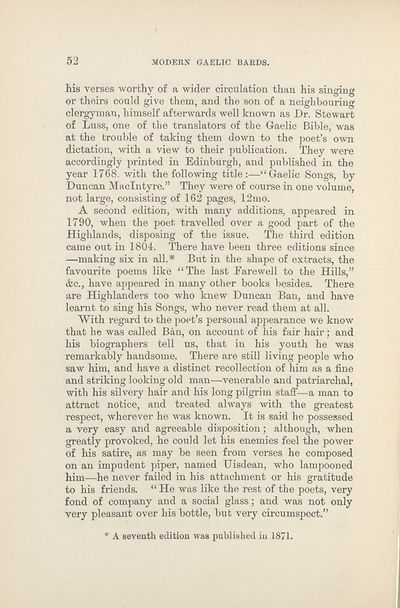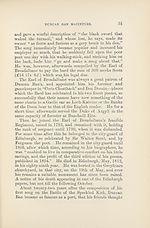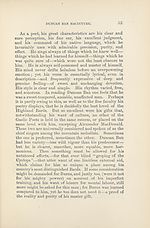Books and other items printed in Gaelic from 1871 to 1900 > Gaelic bards, and original poems
(86) Page 52
Download files
Complete book:
Individual page:
Thumbnail gallery: Grid view | List view

52
MODERN GAELIC BARDS.
his verses worthy of a wider circulation than his singing
or theirs could give them, and the son of a neighbouring
clergyman, himself afterwards well known as Dr. Stewart
of Luss, one of the translators of the Gaelic Bible, was
at the trouble of taking them down to the poet’s own
dictation, with a view to their publication. They were
accordingly printed in Edinburgh, and published in the
year 1768. with the following title:—“Gaelic Songs, by
Duncan MacIntyre.” They were of course in one volume,
not large, consisting of 162 pages, 12mo.
A second edition, with many additions, appeared in
1790, when the poet travelled over a good part of the
Highlands, disposing of the issue. The third edition
came out in 1804. There have been three editions since
—making six in all.* But in the shape of extracts, the
favourite poems like “The last Farewell to the Hills,”
(fee., have appeared in many other books besides. There
are Highlanders too who knew Duncan Ban, and have
learnt to sing his Songs, who never read them at all.
With regard to the poet’s personal appearance we know
that he was called Ban, on account of his fair hair; and
his biographers tell us, that in his youth he was
remarkably handsome. There are still living people who
saw him, and have a distinct recollection of him as a fine
and striking looking old man—venerable and patriarchal,
with his silvery hair and his long pilgrim staff—a man to
attract notice, and treated always with the greatest
respect, wherever he was known. It is said he possessed
a very easy and agreeable disposition; although, when
greatly provoked, he could let his enemies feel the power
of his satire, as may be seen from verses he composed
on an impudent piper, named Uisdean, who lampooned
him—he never failed in his attachment or his gratitude
to his friends. “ He was like the rest of the poets, very
fond of company and a social glass; and was not only
very pleasant over his bottle, but very circumspect.”
* A seventh edition was published in 1871.
MODERN GAELIC BARDS.
his verses worthy of a wider circulation than his singing
or theirs could give them, and the son of a neighbouring
clergyman, himself afterwards well known as Dr. Stewart
of Luss, one of the translators of the Gaelic Bible, was
at the trouble of taking them down to the poet’s own
dictation, with a view to their publication. They were
accordingly printed in Edinburgh, and published in the
year 1768. with the following title:—“Gaelic Songs, by
Duncan MacIntyre.” They were of course in one volume,
not large, consisting of 162 pages, 12mo.
A second edition, with many additions, appeared in
1790, when the poet travelled over a good part of the
Highlands, disposing of the issue. The third edition
came out in 1804. There have been three editions since
—making six in all.* But in the shape of extracts, the
favourite poems like “The last Farewell to the Hills,”
(fee., have appeared in many other books besides. There
are Highlanders too who knew Duncan Ban, and have
learnt to sing his Songs, who never read them at all.
With regard to the poet’s personal appearance we know
that he was called Ban, on account of his fair hair; and
his biographers tell us, that in his youth he was
remarkably handsome. There are still living people who
saw him, and have a distinct recollection of him as a fine
and striking looking old man—venerable and patriarchal,
with his silvery hair and his long pilgrim staff—a man to
attract notice, and treated always with the greatest
respect, wherever he was known. It is said he possessed
a very easy and agreeable disposition; although, when
greatly provoked, he could let his enemies feel the power
of his satire, as may be seen from verses he composed
on an impudent piper, named Uisdean, who lampooned
him—he never failed in his attachment or his gratitude
to his friends. “ He was like the rest of the poets, very
fond of company and a social glass; and was not only
very pleasant over his bottle, but very circumspect.”
* A seventh edition was published in 1871.
Set display mode to:
![]() Universal Viewer |
Universal Viewer | ![]() Mirador |
Large image | Transcription
Mirador |
Large image | Transcription
Images and transcriptions on this page, including medium image downloads, may be used under the Creative Commons Attribution 4.0 International Licence unless otherwise stated. ![]()
| Rare items in Gaelic > Books and other items printed in Gaelic from 1871 to 1900 > Gaelic bards, and original poems > (86) Page 52 |
|---|
| Permanent URL | https://digital.nls.uk/106037607 |
|---|
| Description | Out-of-copyright books printed in Gaelic between 1631 and 1900. Also some pamphlets and chapbooks. Includes poetry and songs, religious books such as catechisms and hymns, and different editions of the Bible and the Psalms. Also includes the second book ever published in Gaelic in 1631. |
|---|

